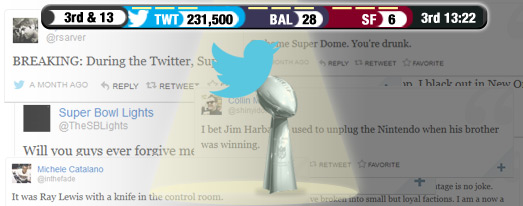
The Super Bowl has always been a powerhouse of insight into the world of marketing and advertising – setting new trends with innovative advertisements that cost tens of millions of dollars to produce and syndicate. This past Super Bowl was a spectacle due to a number of incidents, most notably a power outage in the third quarter that left half the Mercedes-Benz Superdome without lights for over half an hour.
Recent Super Bowls have been noted for the social media activity surrounding them. Twitter users seem to thrive on the event in particular, constantly posting short clips of text throughout it, with national activity peaking during critical moments. This Super Bowl’s Twitter statistics during the blackout incident are of particular note, demonstrating the opportunism necessary to find the greatest success on the social media platform, as well as the increasing popularity and utility of the brand.
Outage Tweets and Popular Response
The 34-minute power outage was a brief but unpredictable window of opportunity for marketers all over the country to jump on. During the power outage alone, over 231,500 tweets were sent out every minute, a statistic now referred to as TPM (tweets per minute). Companies instantly reacted to the situation, sending out tweets immediately to capitalize on the opportunity.
Oreo sent out a tweet that received a massive following, stating, "You can still dunk in the dark," while Tide posted, "We can’t get your blackout. But we can get your stains out." These tweets were just two of the most popular ones in the massive stream flooding the platform during the blackout. Users applauded the response, re-posting and sensationalizing the brief messages to a point where analysts considered Tide and Oreo to be the most successful advertisers of the evening.
How Twitter Rewards Opportunism
These posts were simply knee-jerk reactions to a critical event that nearly everyone in America witnessed, but they illustrated a simple, social media world principle: Twitter rewards opportunism.
With a tight character limit and constantly-changing atmosphere, Twitter is the perfect platform for instant commentary and sharp spikes of popularity. Boring or uneventful posts get buried in a few minutes, but the most successful posts start an explosive chain reaction of reposting and references.
The most successful posts tend to immediately react to something, though this success can be either very positive or very negative. Popular positive posts tend to be punch lines or offers capitalizing on an immediate recent event, as Oreo and Tide demonstrated. Popular negative posts tend to be emotionally-charged insults or outbursts that could damage a company’s reputation or eventually cost millions of dollars in punitive damages.
Either way, the most popular posts on Twitter are those reacting immediately to something significant, meaning the most successful Twitter account managers are instinctively opportunistic. The takeaway: Jump on the moment immediately or the moment will die, along with any possible benefits. Yes, reactionary posts are risky, but they also have the highest possible payoff.
Twitter’s Increasing Role in Advertising
Super Bowl advertisements have always caught the attention of marketers and consumers alike - the thought of millions of dollars being spent for just 30 seconds of airtime is incentive enough to want to watch them.
This year, an informal analysis revealed a somewhat surprising ratio of social media mentions during ad breaks. The 59 national commercials aired after kickoff and before the end of the game were analyzed for social media-related content, with 50 percent mentioned Twitter or hashtags, compared to 8 percent mentioning Facebook, and none mentioning Google+. Instagram and YouTube each received a single mention. This doesn’t necessarily mean Twitter is beating out every other social media platform in popularity and utility, but it does make an interesting case for Twitter’s popularity among advertisers.
The sheer cost associated with Super Bowl advertisements means every second is examined with scrutiny to ensure it maximizes some element of reach to consumers. Mentioning Twitter for a single second could equate to hundreds of thousands of dollars, meaning marketers with the biggest budgets favor Twitter over any other social media platform, at least for a quick mention. This, too, is a type of opportunism: Taking the least amount of time to generate the maximum possible value.
The Bottom Line
Twitter is a social media platform of opportunism, both in terms of what’s posted and how it’s promoted. The most successful and scandalous posts seem to be the ones that serve as core reactions to sudden events, so even though some posts might be risky, the potential payoff is enormous. Furthermore, Twitter seems to be the best social media platform to push when time or space is limited. It’s a concise, reactionary platform that thrives on short moments and instant decisions.
And so far, it hasn't lost power.

